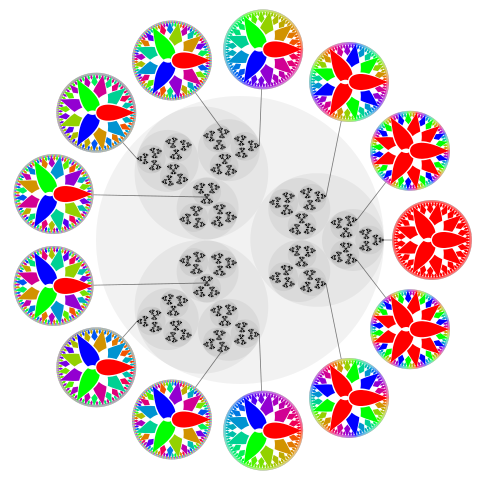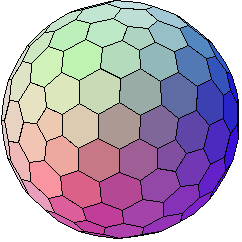 I've known about the rather curious set of p-adic numbers for years, even before they started getting famous with perfectiod spaces, but I never knew there were some of the wildest insights into mathematics buried within their "weird" way of thinking. I put weird in quotes here because although they first seem weird, they're actually very... reasonable. You'll see, they are equally as reasonable as "normal" numbers, when you get to thinking about things.
I've known about the rather curious set of p-adic numbers for years, even before they started getting famous with perfectiod spaces, but I never knew there were some of the wildest insights into mathematics buried within their "weird" way of thinking. I put weird in quotes here because although they first seem weird, they're actually very... reasonable. You'll see, they are equally as reasonable as "normal" numbers, when you get to thinking about things.
Let me set this up properly: A generalization of the p-adic numbers is called "Leftist numbers" by Andrew Rich in a paper published a few years ago, which I just stumbled on thanks to a small reference on Hacker News. His approach may be the most insightful way into understanding the power and wonder of p-adics. Before we dig in to how they work, lemme introduce the author of the paper:
Andrew Rich is in the Mathematics Department at Manchester University in Indiana, where he just won the 2022 Distinguished Teaching Award. The first hint that he's my kind of thinker is in his brief bio, with the following note: "He enjoys ... thinking about mathematics, reading, and running, and he spends too much time on the web following politics (both leftist and rightist)." Emphasis mine.
Someone who enjoys reading on both the left and the right is a rare bird in these polarized times, so rare that any such writer immediately commands my attention. For those who don't already know, the name of my weblog, Clearhat, is a reference to this nonbinary way of seeing things. But I actually missed that bit of bio, because I was led into the article by the brief summary written by David Richeson on the weblog Division by Zero.
Leftist numbers?
Leftist numbers are the opposite of the number system we all know and love, specifically in the way they approach the decimal point, where infinity occurs on the left, not the right. Instead of begin with a few digits to the left of the decimal point (as we normally do) and then extending infinitely to the right (like 12.3456789...), leftist numbers begin with a finite number of digits to the right of the decimal point and extend infinitely to the left (like ...9876543.21).
It turns out that the math of this system is entirely sensible and because it handles extremely large numbers very easily, it brings some fascinating insights into numbers which we normally can't see because of our native orientation to relatively smaller numbers.
For example, calculating the three-billionth digit of pi is the kind of thing we like to do, even though that digit represents something absurdly small. So small, in fact, there is no functional value in calculating pi to that many digits, since it only takes about a dozen digits of pi to handle with perfect precision any real-life need to define a circle of any size in the universe, including the universe itself. The three-billionth digit of pi is really really small.
However, for fun, we program computers to sit around and calculate pi to smaller and smaller pieces -- at a literally insane level of precision -- because it's such a satisfying thing to know that we've done so. We love cutting things up into smaller and smaller pieces, at least here in the West. It's part of our strong tendency to overdo linear, precise things led by the left brain, for those following that model.
But nobody does this with absurdly large numbers, for example numbers which are so large that they are literally "just this side" of infinity, like ...99999999999999999999999.0. (Note the dots toward infinity are on the left). Although impossibly large, this number is simply an entry-level leftist number. People talking about leftist numbers talk about numbers like this all day long, although I'm guessing it's a safe wager that no one has programmed a computer to calculate the three billionth left digit of something.
It turns out that this number is factually the largest number possible this side of infinity -- if you add one to it in the rightist world, you get infinity.
But in the leftist world, you get something that is so wild, yet also so normal and logical, it can break your brain for a few minutes while you stare at the page, trying to figure out what just happened in such an... ordinary way.
So, what happens when you add one to the largest number that can ever be written (now that you know how leftist numbers make it easy to write)? I'll leave it to the more curious to read the article by Andrew Rich to find out what happens, because I've another point I'm trying to make: In the course of explaining how leftist numbers work, and how they overlap with rationals, reals, infinity, and so forth, Andrew Rich writes the funniest paragraph I've ever read while reading math papers. See if you catch it:
Together with the earlier results on the reciprocals of integers divisible only by 2 and 5, this implies that every nonzero integer has a reciprocal in the leftist system; multiplying by integers then shows that all rationals are in the leftist system. So the rational number system is a subring of L. Note that though we have just proven that all rationals are leftists, this does not mean that all leftists are rational. We will not mention any names. (In order not to offend anyone, we hasten to add that it is well known that all rationals are also rightists but not all rightists are rational. Again, we will not mention any names.) In fact, a re-examination of the argument shows that all rationals are repeating leftists. The converse of this statement is that all repeating leftists are rational, and this is true.
I laughed out loud immediately, and was unprofessionally giggling, then eventually chuckling to myself for half an hour or more. Now I'm afraid to go back and read the paragraph again because I know I'll start laughing again. I hope you have a similar experience, but I admit it may be one that is funniest -- releasing long-held tension -- to people like us, clearhats, who live in the middle of the spectrum of left- and right-thinking. We're continually buffeted by people on the left who think we're on the right, and people on the right who think we're on the left, because so few ever see there even is a valid middle.
Since both leftists and rightists will likely find the quoted paragraph offensive, it may only be us in the middle who really appreciate the joke and cannot stop laughing. Let me know in the comments if you found it hilarious also; if you live in the area, we should meet for coffee; odds are we're the only ones in the region, and we should stick together in these perilous times.
So back to p-adics. As I said, I've read a number of articles on these funky numbers for years. Probably the best -- until this one -- was put together recently by Quanta Magazine, An Infinite Universe of Number Systems. They typically have excellent articles, with cool, intuitive graphics to help you understand such things. But even they missed some of the insights turned up by Andrew Rich's article from 2008. I think the idea of calling them "leftist," aside from the humor, is a great way of distilling their essential difference from normal numbers. For example, I see now for the first time how p-adic numbers are a phenomenal way of introducing my own way of thinking about mathematics.
How nice that the funniest thing I've read in mathematics in a dozen years... is also one of the most insightful for my own particular brand of thought experiments. Because math should be fun, I'll see what I can do to parlay this bit of humor into my eventual mathematical magnum opus.

Related Links:
- https://news.ycombinator.com/item?id=34376405 What are p-adic numbers? (2008) (divisbyzero.com) 8 points by jayhoon 11 hours ago
- https://divisbyzero.com/2008/11/24/what-are-p-adic-numbers/ What are p-adic numbers? Posted by DAVE RICHESON on NOVEMBER 24, 2008
- https://divisbyzero.com/2020/04/08/make-a-real-projective-plane-boys-surface-out-of-paper/ Make a Real Projective Plane (Boy’s Surface) out of Paper. Posted by DAVE RICHESON on APRIL 8, 2020 (not exacly relalted, but interesting nonetheless, and coincidentally a link I visited once before. I even tried to make this; it's more complicated than it appears, and it appears complicated.)
- https://divisbyzero.com/blog-division-by-zero/ David Richeson: Division by Zero
- https://www.maa.org/publications/periodicals/college-mathematics-journal/college-mathematics-journal-november-2008 The College Mathematics Journal Contents November 2008. Vol. 39, No. 5, pp. 330-427. ARTICLES. Leftist Numbers. Andrew Rich. 330-336. The leftist number system consists of numbers with decimal digits arranged in strings to the left, instead of to the right. This system fails to be a field only because it contains zero-divisors. The same construction with prime base yields the p-adic numbers.
- https://www.manchester.edu/about-manchester/news/news-articles/2022-news-articles/manchester-professor-andrew-rich-receives-distinguished-teaching-award Manchester’s Andrew Rich receives Distinguished Teaching Award. Mathematics professor to retire, granted emeritus status. The Mathematical Association of America Indiana Section has recognized Manchester University Professor Andrew Rich with its 2022 Distinguished Teaching Award.
- https://www.quantamagazine.org/how-the-towering-p-adic-numbers-work-20201019/ An Infinite Universe of Number Systems. The p-adics form an infinite collection of number systems based on prime numbers. They’re at the heart of modern number theory.
- doi:10.1080/07468342.2008.11922313 Rich, A. (2008). Leftist Numbers. The College Mathematics Journal, 39(5), 330–336.

1 From Feldspar -
Hello fellow chaser of truth, tails and equanimity,
How truly wonderful to find a refuge from the elements hurled about by gods both false and otherwise. I stumbled across the light from your abode while seeking the origins of statement "God is an intelligent sphere...." Parkinson's makes much typing difficult, so let me just say a heartfelt "Thank you dear sir for providing such deeply appreciated lodgings for a foolish old man wise enough to know a fellow fool when he stumbles across one." Be well! - Dan S.